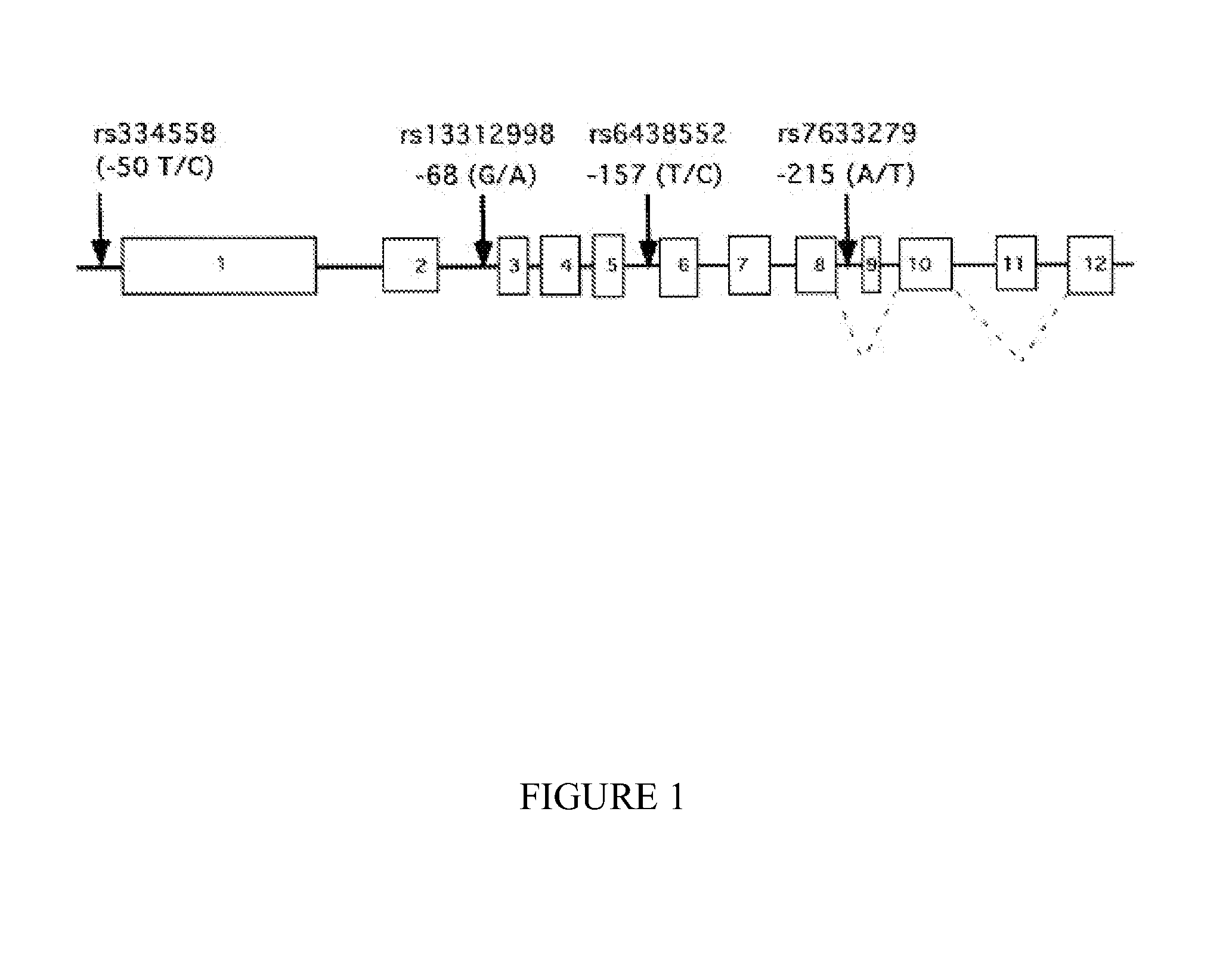Diagnostics and Therapeutics of Neurological Disease
a neurological disease and diagnostic technology, applied in the field of neurological disease diagnostics and therapeutics, can solve the problems of unreliable and subjective current diagnostic approaches for alzheimer's disease, the lack of understanding of the etiological cause of these diseases, and the difficulty of achieving the effect of reducing depressive episodes and reducing manic episodes
- Summary
- Abstract
- Description
- Claims
- Application Information
AI Technical Summary
Benefits of technology
Problems solved by technology
Method used
Image
Examples
example 1
SNPs in GSK-3β that Affect Splicing of Transcripts Thereof
1.1 Samples
[0438]The Caucasian PD cohort used in this analysis comprises 302 cases (128 male and 174 female cases; average age, 66±0.5 years) and 302 control subjects (128 male and 174 female subjects; average age, 66±0.5 years). The cases were referral based and prospectively recruited from hospitals, private neurology clinics, and community support groups throughout the state of Queensland, Australia. PD was diagnosed according to standard criteria if the subject had a combination of three of the following features: resting tremor, rigidity, bradykinesia, and postural instability. The diagnosis was also made when at least two of these features were present with asymmetry in tremor, rigidity, or bradykinesia (Calne et al., Ann Neurol 32:S125-S127, 1992). The control group comprised nondemented healthy individuals who were spouses, siblings, caregivers, or unrelated individuals from various community groups. None of the contr...
example 2
Linkage Disequilibrium of Markers in GSK-3β
Linkage Disequilibrium Analysis
[0451]The Celera database (available from Celera Genomics Rockville, Rockville, Md., USA) and the UCSC Genome Bioinformatics Site (described in Kent et al., Genome Res. 12:996-1006, 2002) were used to identify genes adjacent to GSK-3β. Each flanking gene was examined for known SNPs using the CHUP Bioinformatics Tool (available from the Children's Hospital Informatics Program, Children's Hospital Boston, Boston, Mass., USA). For each gene, two verified SNPs were amplified by PCR and sequenced.
Results
[0452]To determine the extent of linkage disequilibrium (LD) around GSK3β in Caucasian and Chinese populations, 24 individuals from each ethnic group were genotyped for the 5 GSK3β SNPs (rs3755557, rs334558, rs6438552, rs13312998, and 7633279), as well as validated SNPs from 4 flanking genes. Pairwise Lewontin's linkage disequilibrium (LD) coefficient (D′) were calculated (Devlin and Risch, Genomics; 29:311-322, 199...
example 3
Analysis of Splicing of GSK-3β in Patient Samples
Analysis of GSK-3β Transcripts
[0453]Total RNA was extracted from lymphocyte cells derived from subjects homozygous for either the T or C allele at the SNP in intron 5 of GSK-3β. RNA was extracted using the SV Total RNA Isolation System (Promega). 2 μg of RNA was reverse transcribed using the Superscript II RT enzyme (GibcoBRL) and a random hexamer primer (GibcoBRL), followed by PCR amplification using the primers GSKRT-2F (5′-TGTTGGAGTTCCCAGGACCTTG-3′) (SEQ ID NO: 25) and GSKRT-R (5′-AGTAACTGGTGGTTTTTCCTGTGC-3′) (SEQ ID NO: 26).
[0454]The relative ratio of PCR products with or without exon 9 and exon 11 sequences was determined semi-quantitatively by PCR amplification essentially as described by Stanford et al., Brain, 123, 880-893, 2000) using 0.2 μg of cDNA template and 33P end-labeled GSKRT-F primer.
Western Blot Analysis of GSK-3β
[0455]Approximately 25 μg of protein lysates from lymphocytes were heated to 95° C. for 10 minutes prior...
PUM
| Property | Measurement | Unit |
|---|---|---|
| temperature | aaaaa | aaaaa |
| temperature | aaaaa | aaaaa |
| Tm | aaaaa | aaaaa |
Abstract
Description
Claims
Application Information
 Login to View More
Login to View More - R&D
- Intellectual Property
- Life Sciences
- Materials
- Tech Scout
- Unparalleled Data Quality
- Higher Quality Content
- 60% Fewer Hallucinations
Browse by: Latest US Patents, China's latest patents, Technical Efficacy Thesaurus, Application Domain, Technology Topic, Popular Technical Reports.
© 2025 PatSnap. All rights reserved.Legal|Privacy policy|Modern Slavery Act Transparency Statement|Sitemap|About US| Contact US: help@patsnap.com



